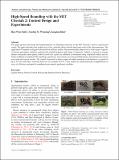| dc.contributor.author | Park, Hae-Won | |
| dc.contributor.author | Wensing, Patrick M. | |
| dc.contributor.author | Kim, Sangbae | |
| dc.date.accessioned | 2018-12-18T18:21:36Z | |
| dc.date.available | 2018-12-18T18:21:36Z | |
| dc.date.issued | 2017-02 | |
| dc.identifier.issn | 0278-3649 | |
| dc.identifier.issn | 1741-3176 | |
| dc.identifier.uri | http://hdl.handle.net/1721.1/119686 | |
| dc.description.abstract | This paper presents the design and implementation of a bounding controller for the MIT Cheetah 2 and its experimental results. The paper introduces the architecture of the controller along with the functional roles of its subcomponents. The application of impulse scaling provides feedforward force profiles that automatically adapt across a wide range of speeds. A discrete gait pattern stabilizer maintains the footfall sequence and timing. Continuous feedback is layered to manage balance during the stance phase. Stable hybrid limit cycles are exhibited in simulation using simplified models, and are further validated in untethered three-dimensional bounding experiments. Experiments are conducted both indoors and outdoors on various man-made and natural terrains. The control framework is shown to provide stable bounding in the hardware, at speeds of up to 6.4 m/s and with a minimum total cost of transport of 0.47. These results are unprecedented accomplishments in terms of efficiency and speed in untethered experimental quadruped machines. Keywords: Legged Robots, Motion Control, Biologically-Inspired Robots, Dynamics | en_US |
| dc.publisher | SAGE Publications | en_US |
| dc.relation.isversionof | http://dx.doi.org/10.1177/0278364917694244 | en_US |
| dc.rights | Creative Commons Attribution-Noncommercial-Share Alike | en_US |
| dc.rights.uri | http://creativecommons.org/licenses/by-nc-sa/4.0/ | en_US |
| dc.source | Other repository | en_US |
| dc.title | High-speed bounding with the MIT Cheetah 2: Control design and experiments | en_US |
| dc.type | Article | en_US |
| dc.identifier.citation | Park, Hae-Won, Patrick M Wensing, and Sangbae Kim. “High-Speed Bounding with the MIT Cheetah 2: Control Design and Experiments.” The International Journal of Robotics Research 36, no. 2 (February 2017): 167–192. © 2017 The Authors | en_US |
| dc.contributor.department | Massachusetts Institute of Technology. Department of Mechanical Engineering | en_US |
| dc.contributor.mitauthor | Wensing, Patrick M. | |
| dc.contributor.mitauthor | Kim, Sangbae | |
| dc.relation.journal | The International Journal of Robotics Research | en_US |
| dc.eprint.version | Author's final manuscript | en_US |
| dc.type.uri | http://purl.org/eprint/type/JournalArticle | en_US |
| eprint.status | http://purl.org/eprint/status/PeerReviewed | en_US |
| dc.date.updated | 2018-12-10T20:02:57Z | |
| dspace.orderedauthors | Park, Hae-Won; Wensing, Patrick M; Kim, Sangbae | en_US |
| dspace.embargo.terms | N | en_US |
| dc.identifier.orcid | https://orcid.org/0000-0002-9041-5175 | |
| dc.identifier.orcid | https://orcid.org/0000-0002-0218-6801 | |
| mit.license | OPEN_ACCESS_POLICY | en_US |
